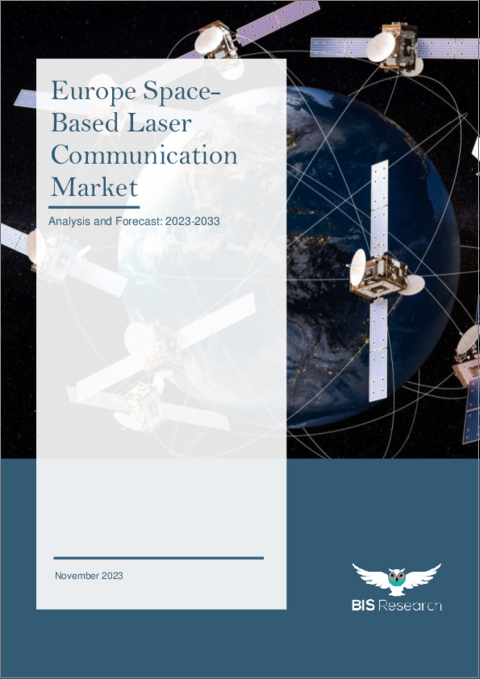|
|
市場調査レポート
商品コード
1374892
欧州の宇宙ベースレーザー通信市場の分析・予測:2023-2033年Europe Space-Based Laser Communication Market - Analysis and Forecast, 2023-2033 |
||||||
カスタマイズ可能
|
|||||||
| 欧州の宇宙ベースレーザー通信市場の分析・予測:2023-2033年 |
|
出版日: 2023年11月02日
発行: BIS Research
ページ情報: 英文 68 Pages
納期: 1~5営業日
|
全表示
- 概要
- 図表
- 目次
欧州の宇宙ベースレーザー通信の市場規模は、2022年の2億5,390万米ドルから、予測期間中は10.55%のCAGRで推移し、2033年には13億1,330万米ドルの規模に成長すると予測されています。
欧州は、宇宙ベースレーザー通信市場の成長が顕著な地域の1つです。Airbus Defense and Space、Eutelsat、SES、Thales Alenia Spaceといった欧州の主要企業で構成される宇宙・通信企業のコンソーシアムは、SpaceXの Starlinkシステムに匹敵する衛星コンステレーション案の入札に参加しました。欧州連合 (EU) が主導するこのプロジェクトには、2023年に26億4,000万米ドルという多額の資金が投入されています。さらに、このプロジェクトは欧州宇宙機関や民間からもさらなる資金を確保し、全体的な資金調達能力を強化する見込みです。
また、衛星間リンク (ISL) を備えた第2世代衛星の導入により、欧州の宇宙ベースレーザー通信市場は顕著に拡大しています。AI、電子制御アンテナ (ESA) 、コンポーネントの小型化、ISLなど、地上と宇宙の双方での通信性能を向上させる最新技術が主にこの成長を後押ししています。
当レポートでは、欧州の宇宙ベースレーザー通信の市場を調査し、市場概要、市場成長への各種影響因子の分析、市場規模の推移・予測、各種区分・地域/主要国別の詳細分析、競合情勢、主要企業の分析などをまとめています。
欧州の宇宙ベースレーザー通信市場:イントロダクション
| 主要市場統計 | |
|---|---|
| 予測期間 | 2023-2033年 |
| 2023年評価 | 4億8,170万米ドル |
| 2033年予測 | 13億1,330万米ドル |
| CAGR | 10.55% |
市場区分:
セグメンテーション1:エンドユーザー別
- 政府・軍
- 商用
セグメント2:ソリューション別
- 宇宙対宇宙
- 宇宙対その他のアプリケーション
- 宇宙対地上ステーション
セグメント3:地域別
- 欧州:英国、フランス、ドイツ、ロシア、その他
目次
第1章 市場
- サプライチェーン分析
第2章 欧州
- 世界の宇宙レーザー通信市場:地域別
- 欧州
- 市場別
- 用途別
- 製品別
- 国別
第3章 市場:競合ベンチマーキング・企業プロファイル
- 競合ベンチマーキング
- HENSOLDT
- Mynaric
- ODYSSEUS SPACE SA
- Tesat-Spacecom GmbH & Co.
- Thales Alenia Space
- その他
第4章 調査手法
List of Figures
- Figure 1: Europe Space-Based Laser Communication Market, Units, 2022-2033
- Figure 2: Europe Space-Based Laser Communication Market, $Billion, 2022-2033
- Figure 3: Europe Space-Based Laser Communication Market (by End User), $Billion, 2023 and 2033
- Figure 4: Europe Space-Based Laser Communication Market (by End User), Units, 2023 and 2033
- Figure 5: Europe Space-Based Laser Communication Market (by Application), $Million, 2023 and 2033
- Figure 6: Europe Space-Based Laser Communication Market (by Application), Units, 2023 and 2033
- Figure 7: Europe Space-Based Laser Communication Market (by Solution), Units, 2023 and 2033
- Figure 8: Europe Space-Based Laser Communication Market (by Solution), $Million, 2023 and 2033
- Figure 9: Europe Space-Based Laser Communication Market (by Component), $Billion, 2023 and 2033
- Figure 10: Europe Space-Based Laser Communication Market (by Range), $Billion, 2023 and 2033
- Figure 11: Space-Based Laser Communication Market (by Region), $Billion, 2033
- Figure 12: Supply Chain Analysis for the Europe Space-Based Laser Communication Market
- Figure 13: Global Space-Based Laser Communication Market:Competitive Benchmarking, 2022
- Figure 14: Research Methodology
- Figure 15: Top-Down and Bottom-Up Approach
- Figure 16: Assumptions and Limitations
List of Tables
- Table 1: Global Space-Based Laser Communication Market (by Region), Units and $Million, 2022-2033
- Table 2: Europe Space-Based Laser Communication Market (by End User), Units and $Million, 2022-2033
- Table 3: Europe Space-Based Laser Communication Market (by Solution), Units and $Million, 2022-2033
- Table 4: France Space-Based Laser Communication Market (by End User), Units and $Million, 2022-2033
- Table 5: France Space-Based Laser Communication Market (by Solution), Units and $Million, 2022-2033
- Table 6: Germany Space-Based Laser Communication Market (by End User), Units and $Million, 2022-2033
- Table 7: Germany Space-Based Laser Communication Market (by Solution), Units and $Million, 2022-2033
- Table 8: Russia Space-Based Laser Communication Market (by End User), Units and $Million, 2022-2033
- Table 9: Russia Space-Based Laser Communication Market (by Solution), Units and $Million, 2022-2033
- Table 10: U.K. Space-Based Laser Communication Market (by End User), Units and $Million, 2022-2033
- Table 11: U.K. Space-Based Laser Communication Market (by Solution), Units and $Million, 2022-2033
- Table 12: Rest-of-Europe Space-Based Laser Communication Market (by End User), Units and $Million, 2022-2033
- Table 13: Rest-of-Europe Space-Based Laser Communication Market (by Solution), Units and $Million, 2022-2033
- Table 14: Benchmarking and Weightage Parameters
- Table 15: HENSOLDT: Product Portfolio
- Table 16: HENSOLDT: Market Developments
- Table 17: HENSOLDT: Partnerships, Collaborations, Contracts and Agreements
- Table 18: Mynaric: Product Portfolio
- Table 19: Mynaric: Market Developments
- Table 20: Mynaric: Partnerships, Collaborations, Contracts and Agreements
- Table 21: ODYSSEUS SPACE SA: Product Portfolio
- Table 22: ODYSSEUS SPACE SA: Partnerships, Collaborations, Contracts and Agreements
- Table 23: Tesat-Spacecom GmbH & Co.: Product Portfolio
- Table 24: Tesat-Spacecom GmbH & Co.: Market Developments
- Table 25: Tesat-Spacecom GmbH & Co.: Partnerships, Collaborations, Contracts and Agreements
- Table 26: Thales Alenia Space: Product Portfolio
- Table 27: Thales Alenia Space: Market Developments
“The Europe Space-Based Laser Communication Market Expected to Reach $1,313.3 Million by 2033.”
Introduction to Europe Space-based Laser Communication Market
| KEY MARKET STATISTICS | |
|---|---|
| Forecast Period | 2023 - 2033 |
| 2023 Evaluation | $481.7 Million |
| 2033 Forecast | $1,313.3 Million |
| CAGR | 10.55% |
The Europe space-based laser communication market is projected to reach $1,313.3 million by 2033 from $253.9 million in 2022, growing at a CAGR of 10.55% during the forecast period 2023-2033.
Europe is one of the prominent regions for the growth of the space-based laser communication market. A consortium of prominent European space and telecommunications companies, comprising Airbus Defense and Space, Eutelsat, SES, and Thales Alenia Space, has joined forces to submit a bid for a proposed satellite constellation that aims to rival SpaceX's Starlink system. With the European Union (EU) taking the lead, the project will receive a substantial funding commitment of $2.64 billion in 2023. Additionally, the project is expected to secure further financial support from the European Space Agency and private investments, bolstering its overall funding capacity.
Market Introduction
The introduction of second-generation satellites with intersatellite links (ISL) has resulted in a notable increase in the market for space-based laser communication in Europe. Modern technologies that improve communication performance both on Earth and in space, such as artificial intelligence (AI), electronically steered antennas (ESAs), component miniaturization, and ISLs, are primarily driving this rise.
Prominent firms that are creating massive constellations in low Earth orbit (LEO) and medium Earth orbit (MEO), such OneWeb, SpaceX, and Amazon's Project Kuiper, also have an impact on the market's trajectory. 2023 will see the integration of laser terminals by low Earth orbit satellites, such those operated by Starlink, into a constellation with optical intersatellite connections (OISLs), producing a strong mesh network in orbit. When it is fully deployed, Telesat's LightSpeed constellation also intends to include optical satellite links, while OneWeb is considering include optical links in its second phase of rollout. Inter-satellite links are made easier by the inherent nature of Amazon's Kuiper constellation.
To bring cutting-edge and novel products, major participants in this industry, such as Tesat-Spacecom GmbH & Co., SKYLOOM, Bridgecomm, and Mynaric, are substantially investing in research and development.
Market Segmentation:
Segmentation 1: by End User
- Government and Military
- Commercial
Segmentation 2: by Solution
- Space-to-Space
- Space-to-Other Application
- Space-to-Ground Station
Segmentation 3: by Region
- Europe - U.K., France, Germany, Russia, and Rest-of-Europe
How this Report Can Add Value
Product/Innovation Strategy: The product segment helps the reader understand the different types of components available for deployment and their potential globally. Moreover, the study provides the reader with a detailed understanding of the europe space-based laser communication market by end user and solution.
Growth/Marketing Strategy: The europe space-based laser communication market has seen major development by key players operating in the market, such as contract, collaboration, and joint venture. The favored strategy for the companies has been contracts to strengthen their position in the europe space-based laser communication market.
Competitive Strategy: Key players in the europe space-based laser communication market analyzed and profiled in the study involve major europe space-based laser communication companies providing components. Moreover, a detailed market share analysis of the players operating in the europe space-based laser communication market has been done to help the reader understand how players stack against each other, presenting a clear market landscape. Additionally, comprehensive competitive strategies such as partnerships, agreements, and collaborations will aid the reader in understanding the untapped revenue pockets in the market.
Methodology: The research methodology design adopted for this specific study includes a mix of data collected from primary and secondary data sources. Both primary resources (key players, market leaders, and in-house experts) and secondary research (a host of paid and unpaid databases), along with analytical tools, are employed to build the predictive and forecast models.
Data and validation have been taken into consideration from both primary sources as well as secondary sources.
Table of Contents
1 Market
- 1.1 Supply Chain Analysis
2 Europe
- 2.1 Global Space-Based Laser Communication Market (by Region)
- 2.2 Europe
- 2.2.1 Market
- 2.2.1.1 Key Manufacturers and Suppliers in Europe
- 2.2.1.2 Business Drivers
- 2.2.1.3 Business Challenges
- 2.2.2 Application
- 2.2.2.1 Europe Space-Based Laser Communication Market (by End User), Value and Volume Data
- 2.2.3 Product
- 2.2.3.1 Europe Space-Based Laser Communication Market (by Solution), Value and Volume Data
- 2.2.4 Europe (by Country)
- 2.2.4.1 France
- 2.2.4.1.1 Market
- 2.2.4.1.1.1 Key Manufacturers and Suppliers in France
- 2.2.4.1.2 Application
- 2.2.4.1.2.1 France Space-Based Laser Communication Market (by End User), Value and Volume Data
- 2.2.4.1.3 Product
- 2.2.4.1.3.1 France Space-Based Laser Communication Market (by Solution), Value and Volume Data
- 2.2.4.1.1 Market
- 2.2.4.2 Germany
- 2.2.4.2.1 Market
- 2.2.4.2.1.1 Key Manufacturers and Suppliers in Germany
- 2.2.4.2.2 Application
- 2.2.4.2.2.1 Germany Space-Based Laser Communication Market (by End User), Value and Volume Data
- 2.2.4.2.3 Product
- 2.2.4.2.3.1 Germany Space-Based Laser Communication Market (by Solution), Value and Volume Data
- 2.2.4.2.1 Market
- 2.2.4.3 Russia
- 2.2.4.3.1 Market
- 2.2.4.3.1.1 Key Manufacturers and Suppliers in Russia
- 2.2.4.3.2 Application
- 2.2.4.3.2.1 Russia Space-Based Laser Communication Market (by End User), Value and Volume Data
- 2.2.4.3.3 Product
- 2.2.4.3.3.1 Russia Space-Based Laser Communication Market (by Solution), Value and Volume Data
- 2.2.4.3.1 Market
- 2.2.4.4 U.K.
- 2.2.4.4.1 Market
- 2.2.4.4.1.1 Key Manufacturers and Suppliers in the U.K.
- 2.2.4.4.2 Application
- 2.2.4.4.2.1 U.K. Space-Based Laser Communication Market (by End User), Value and Volume Data
- 2.2.4.4.3 Product
- 2.2.4.4.3.1 U.K. Space-Based Laser Communication Market (by Solution), Value and Volume Data
- 2.2.4.4.1 Market
- 2.2.4.5 Rest-of-Europe
- 2.2.4.5.1 Market
- 2.2.4.5.1.1 Key Manufacturers and Suppliers in the Rest-of-Europe
- 2.2.4.5.2 Application
- 2.2.4.5.2.1 Rest-of-Europe Space-Based Laser Communication Market (by End User), Value and Volume Data
- 2.2.4.5.3 Product
- 2.2.4.5.3.1 Rest-of-Europe Space-Based Laser Communication Market (by Solution), Value and Volume Data
- 2.2.4.5.1 Market
- 2.2.4.1 France
- 2.2.1 Market
3 Markets - Competitive Benchmarking & Company Profiles
- 3.1 Competitive Benchmarking
- 3.2 HENSOLDT
- 3.2.1 Company Overview
- 3.2.1.1 Role of HENSOLDT in the Europe Space-Based Laser Communication Market
- 3.2.1.2 Product Portfolio
- 3.2.2 Business Strategies
- 3.2.2.1 Market Developments
- 3.2.3 Corporate Strategies
- 3.2.3.1 Partnerships, Collaborations, Contracts and Agreements
- 3.2.4 Analyst View
- 3.2.1 Company Overview
- 3.3 Mynaric
- 3.3.1 Company Overview
- 3.3.1.1 Role of Mynaric in the Europe Space-Based Laser Communication Market
- 3.3.1.2 Product Portfolio
- 3.3.2 Business Strategies
- 3.3.2.1 Market Developments
- 3.3.3 Corporate Strategies
- 3.3.3.1 Partnerships, Collaborations, Contracts and Agreements
- 3.3.4 Analyst View
- 3.3.1 Company Overview
- 3.4 ODYSSEUS SPACE SA
- 3.4.1 Company Overview
- 3.4.1.1 Role of ODYSSEUS SPACE SA in the Europe Space-Based Laser Communication Market
- 3.4.1.2 Product Portfolio
- 3.4.2 Corporate Strategies
- 3.4.2.1 Partnerships, Collaborations, Contracts and Agreements
- 3.4.3 Analyst View
- 3.4.1 Company Overview
- 3.5 Tesat-Spacecom GmbH & Co.
- 3.5.1 Company Overview
- 3.5.1.1 Role of Tesat-Spacecom GmbH & Co. in the Europe Space-Based Laser Communication Market
- 3.5.1.2 Product Portfolio
- 3.5.2 Business Strategies
- 3.5.2.1 Market Developments
- 3.5.3 Corporate Strategies
- 3.5.3.1 Partnerships, Collaborations, Agreements, and Contracts
- 3.5.4 Analyst View
- 3.5.1 Company Overview
- 3.6 Thales Alenia Space
- 3.6.1 Company Overview
- 3.6.1.1 Role of Thales Alenia Space in the Europe Space-Based Laser Communication Market
- 3.6.1.2 Product Portfolio
- 3.6.2 Business Strategies
- 3.6.2.1 Market Developments
- 3.6.3 Analyst View
- 3.6.1 Company Overview
- 3.7 Other Key Participants
4 Research Methodology
- 4.1 Factors for Data Prediction and Modeling






